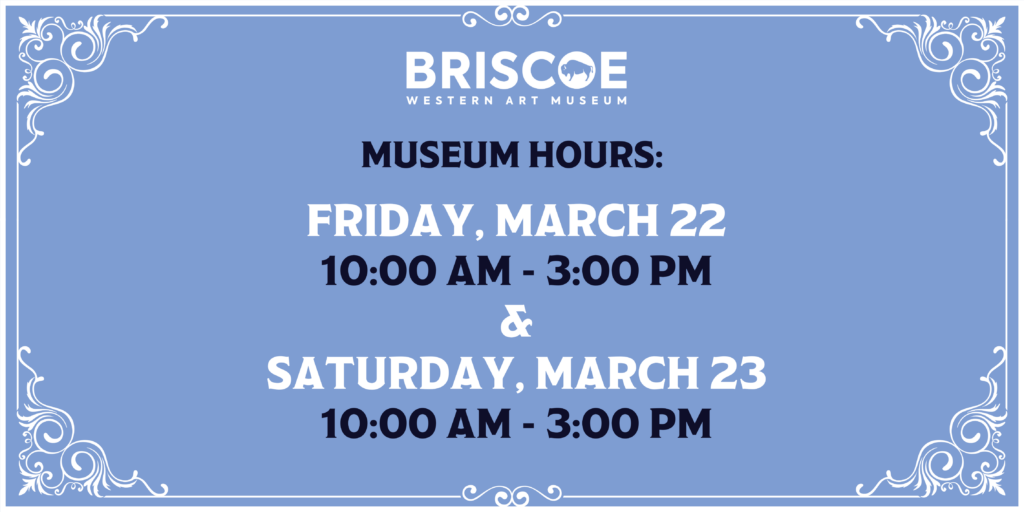Georgia O’Keeffe—Western Artist

In these days of social distancing, extroverts find themselves starved for social interaction, while introverts revel in their solitude. One of the most prominent introverted artists has to be Georgia O’Keeffe. The image she created for herself as a lone wanderer/artist in the rocky country around Ghost Canyon communicates a sense of loneliness and freedom, as if she had always been part of the Western American landscape. Her black frock moving, in stark contrast to the iron-enriched New Mexican landscape, only reinforced this image. Throughout her sixty-year exploration of Western landscapes and Western themes in her work, O’Keeffe became one of the greatest and best-known Western artists.
In the Briscoe Western Art Museum, in the Ruth McLean Bowman Bowers Women of the West Gallery hangs one of O’Keeffe’s pieces, a work on loan from the McNay Art Museum titled The Goat’s Head. This piece is typical of the Western themes that O’Keeffe became known for after her initial visit to New Mexico in the 1920s, and before she moved there permanently in 1949. O’Keeffe often expressed the feeling that the landscape and the mountains surrounding her home at Ghost Ranch were “promised to her by God.” Utilizing her talent for modern abstraction, which she had honed in her composition of her signature flowers, O’Keeffe studied the landscape at different times of day and the ways in which light brought out subtle colors in the sedimentary rock. In the case of The Goat Head, she studied the shapes of bleached bones in the desert. While O’Keeffe never considered her depictions of bones symbols of death, these skulls have become a symbol of the arid and often harsh Western climate. Through her deep, solitary studies of her subjects, O’Keeffe fell deeper in love with the landscape and her place in it.

Like Charles M. Russell and Frederic Remington, Georgia O’Keeffe was not born in the West, having spent most of her formative years in Wisconsin and New York. However, she adopted a country that inspired her and shaped her work and her lifestyle. In a 1977 interview, O’Keeffe talks about her early desire to see the American West and how, when she was a young girl in Wisconsin, her mother would read her and her sisters stories about the wild American frontier. It was this early influence that she credits with motivating her decision to move to Canyon, Texas, to teach art. Although she excelled as a realist, O’Keeffe found more satisfaction in depicting the variations in light out in the Texas Panhandle and interpreting Palo Duro Canyon by color rather than meticulous rendering. Her approach to abstract landscape painting impressed Alfred Stieglitz, who hosted O’Keeffe’s first show and set her on her course as a professional artist. Although she eventually married Stieglitz and lived for thirty years in New York, her heart was never in the city, and she spent part of every year in New Mexico, eventually moving there permanently after Stieglitz’s death. The Goat’s Head and her other New Mexican work represents her love affair with the West. She once called her adopted southwestern home “Such a beautiful, untouched lonely feeling place, such a fine part of what I call the ‘Faraway.’ It is a place I have painted before … even now I must do it again.” Although she was a supremely talented artist before she came to New Mexico, she truly found herself there and, in her solitude, gave others a new way to see the West.
This blog entry was written by our Curator of Collections, Ryan Badger. Ryan has been at the Briscoe for two years and his primary focus as Curator of Collections is bringing the stories of the Briscoe to life through the curation of the collection.
BECOME A MEMBER
Help us bring the spirit of the West alive by becoming a Briscoe Partner!
Click here to become a member!
SUPPORT THE MUSEUM
Governor Dolph Briscoe and his wife Janey envisioned a Museum that would preserve the stories and traditions of the American West.






